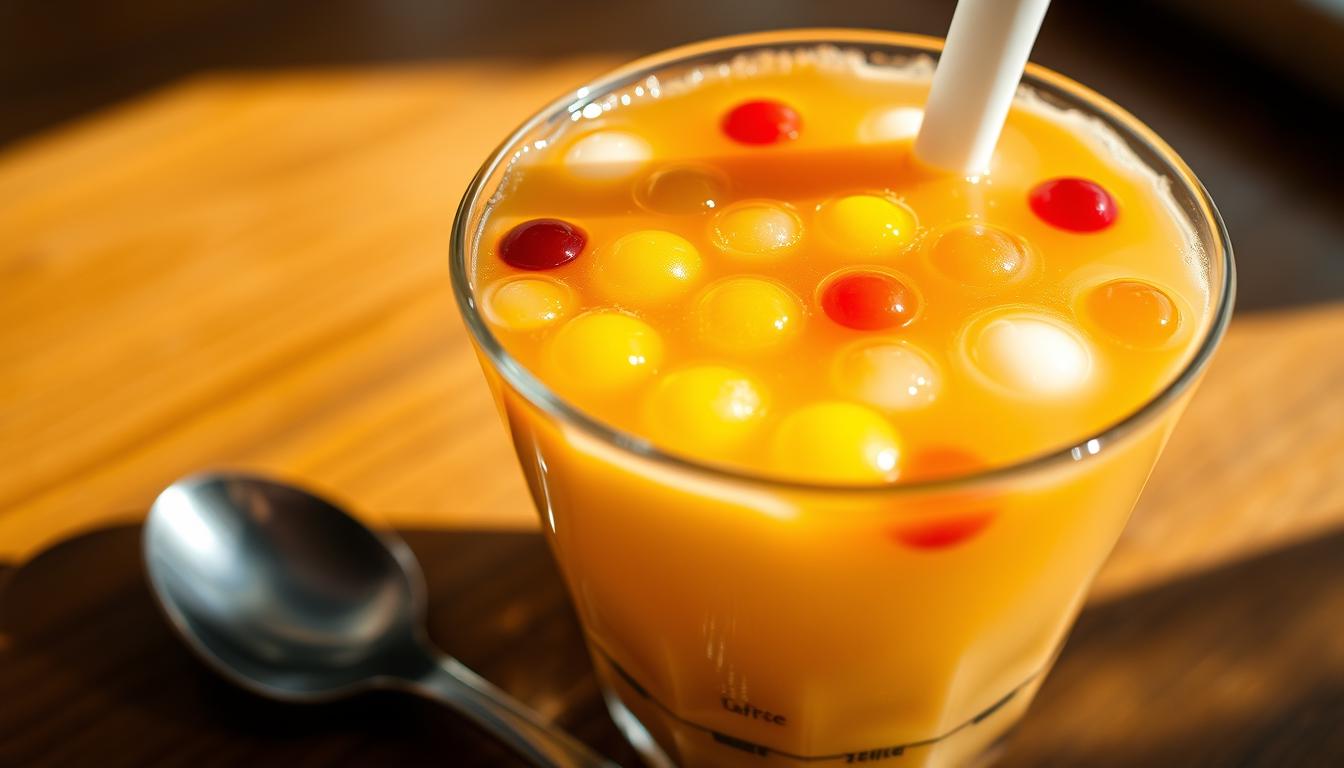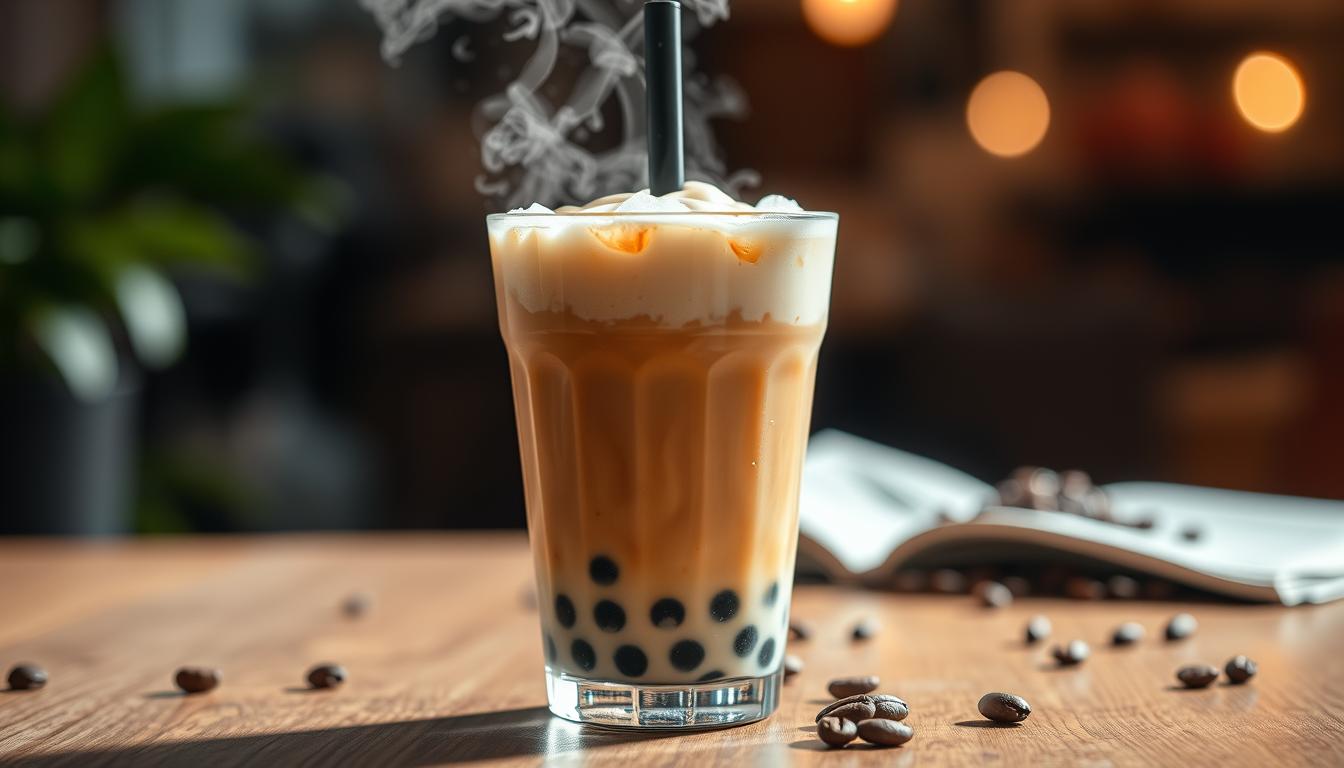Did you know that over 90% of boba tea drinks contain some level of caffeine? This popular beverage, often enjoyed for its unique blend of flavors and chewy tapioca pearls, is more than just a sweet treat. Whether you’re sipping on black tea, green tea, or a milk tea base, caffeine is usually part of the mix.
The amount of caffeine in your drink can vary widely. Factors like the type of tea used, brewing time, and even the shop’s recipe play a role. For example, a cup of black tea-based boba may pack more caffeine than one made with green tea. However, most options still contain less caffeine than a standard cup of coffee.
Understanding the caffeine content in your favorite beverage can help you make informed choices. Whether you’re looking for a mild pick-me-up or a caffeine-free option, this guide will explore everything you need to know about bubble tea and its caffeine levels.
Key Takeaways
- Most boba tea drinks contain caffeine, depending on the tea base used.
- Black tea-based bubble tea typically has higher caffeine levels than green tea.
- The caffeine content varies based on brewing time and preparation methods.
- Bubble tea generally contains less caffeine than a cup of coffee.
- Customization options allow you to adjust caffeine levels to suit your preferences.
Introduction to Bubble Tea and Its Caffeine Buzz
Known for its chewy pearls and creamy base, bubble tea is a modern classic. This iconic drink blends tea, milk, and tapioca pearls for a unique experience. Originating in Taiwan, it has become a global favorite, loved for its versatility and flavor combinations.

What is Bubble Tea?
Bubble tea, also called boba tea, is a refreshing beverage that combines tea with milk or fruit flavors. The addition of chewy tapioca pearls gives it a distinctive texture. Whether you prefer black tea, green tea, or herbal blends, this drink offers endless customization options.
Caffeine in Tea Versus Coffee
While both tea and coffee contain caffeine, their effects differ. A typical cup of coffee delivers a sharp energy boost, whereas tea provides a more gradual lift. For example, black tea has about half the caffeine of coffee, making it a milder option. Green tea, on the other hand, contains even less, offering a gentler pick-me-up.
The brewing process also plays a role in caffeine content. Longer steeping times increase the amount of caffeine in your drink. This means that even within the same type of tea, caffeine levels can vary based on preparation.
Bubble tea, with its tea base, naturally contains caffeine. However, its effects are often more subtle compared to a standard cup of coffee. This makes it a great choice for those seeking a balanced energy boost without the jitters.
Customization is a key feature of bubble tea. From choosing the tea base to adjusting sweetness levels, you can tailor your drink to suit your preferences. This flexibility ensures that every sip is just right for you.
Caffeine Basics in Your Boba Beverage
Ever wondered how much caffeine is in your favorite boba drink? The answer depends on the tea base used. Whether it’s black, green, or oolong, each type brings a unique caffeine profile to your beverage.

Average Caffeine Levels in Different Tea Bases
Black tea typically contains around 47 mg of caffeine per 8-ounce serving. Green tea, on the other hand, has about 28 mg, while oolong falls somewhere in between. These numbers can vary based on brewing time and the amount of tea used.
For comparison, an 8-ounce cup of coffee packs 70-140 mg of caffeine. This makes boba drinks a milder option for those seeking a gentler energy boost.
Understanding Variations Across Drinks
The strength of the tea base plays a significant role in caffeine content. A longer brewing time or a higher tea-to-water ratio can increase the caffeine levels. However, preparation methods and shop practices can also cause variations.
While averages provide a good guideline, the actual caffeine content in your drink may differ. This is why it’s essential to consider factors like tea type and brewing techniques when choosing your boba beverage.
Understanding these basics sets the stage for exploring how tea selection and extraction methods impact caffeine levels in the next section.
does bubble tea have caffeine: Factors and Tea Types
From tea type to brewing methods, multiple elements shape the caffeine in your boba. Whether you’re sipping on a classic milk tea or a fruity blend, understanding these factors can help you customize your drink to your liking.
How Tea Type and Brewing Method Affect Caffeine
The type of tea used in your boba plays a significant role in its caffeine content. For instance, black tea typically contains more caffeine than green tea. A standard 8-ounce cup of black tea has around 47 mg of caffeine, while green tea offers about 28 mg.
Brewing methods also matter. Longer steeping times and hotter water increase caffeine extraction. This means that even within the same type of tea, caffeine levels can vary based on how it’s prepared.
Individual boba shops may have their own practices, leading to further variations. For example, one shop might brew their tea stronger, resulting in higher caffeine content. Always ask about their brewing process if you’re sensitive to caffeine.
The Role of Milk, Syrups, and Flavors
Additives like milk, syrups, and flavorings can change the perception of caffeine strength without altering the actual amount. For example, a creamy milk tea might feel less intense than a plain black tea, even if both contain similar caffeine levels.
Fruit-based boba drinks often use herbal or green tea bases, which naturally have lower caffeine content. This makes them a great option for those seeking a milder energy boost.
Customization is key. By choosing your tea base and adjusting brewing factors, you can tailor your boba to suit your caffeine preferences. Whether you want a strong pick-me-up or a gentle sip, the choice is yours.
Exploring Caffeine-Free and Low-Caffeine Alternatives
Looking for a caffeine-free way to enjoy bubble tea? You’re in luck! Many variants of this beloved drink skip the caffeine while keeping all the flavor and fun. Whether you’re sensitive to caffeine or simply prefer to avoid it, there’s a bubble tea option for you.
Caffeine-Free Bubble Tea Variants
Popular caffeine-free options include Wintermelon Tea, Ginger Tea, and taro-based drinks. These use non-caffeinated ingredients like fruit, herbs, or root extracts. For example, Wintermelon Tea offers a sweet, refreshing taste, while Ginger Tea adds a spicy kick. Taro-based drinks, made from the starchy root, are creamy and slightly nutty.
Some shops also offer decaf versions of traditional tea-based drinks. While the choices may be narrower, they still provide the iconic bubble tea experience. You can enjoy the chewy pearls, creamy milk, and unique flavors without worrying about caffeine content.
| Drink | Base Ingredient | Flavor Profile |
|---|---|---|
| Wintermelon Tea | Wintermelon | Sweet, Refreshing |
| Ginger Tea | Ginger Root | Spicy, Warm |
| Taro Milk Tea | Taro Root | Creamy, Nutty |
These caffeine-free options are perfect for those who want to enjoy bubble tea at any time of day. They’re also a great choice for kids or anyone looking for a healthier alternative to sugary sodas or energy drinks.
Next time you visit your favorite tea shop, don’t hesitate to ask about their caffeine-free options. With so many delicious choices, you can still savor the bubble tea experience without the buzz.
Tips for Customizing Your Bubble Tea Experience
Customizing your bubble tea is easier than you think. Whether you’re looking to adjust caffeine levels or tweak the flavor, a few simple changes can make all the difference. From brew strength to tea amount, here’s how to tailor your drink to your exact preferences.
Adjusting Brew Strength and Tea Amount
One of the easiest ways to control your caffeine intake is by adjusting the brew strength. A shorter steeping time results in a milder flavor and lower caffeine content. If you prefer a bolder taste, ask for a longer brew or extra tea leaves.
Here are some practical tips to help you customize your boba tea:
- Ask for a lighter brew if you’re sensitive to caffeine.
- Choose fewer tea leaves for a milder flavor.
- Experiment with steeping times to find your perfect balance.
Mixing tea with milk or other flavorings can also change the overall balance of your drink. For example, a creamy milk tea might feel smoother, even if it contains the same amount of caffeine as a plain tea base.
Many boba shops are happy to accommodate custom requests. Don’t hesitate to ask for adjustments like less steep time or fewer tea leaves. This way, you can enjoy your drink without worrying about unwanted side effects.
By understanding these simple tweaks, you can create a bubble tea that’s perfect for your taste and energy needs. Whether you’re at a shop or making it at home, customization is key to the ultimate boba experience.
Conclusion
Most boba tea drinks contain caffeine due to their tea base, but the exact amount varies. Factors like the type of tea, brewing time, and added ingredients play a role. For example, black tea typically has more caffeine than green tea.
If you’re looking to avoid caffeine, there are plenty of alternatives. Options like Wintermelon or Taro-based drinks offer the same great flavor without the buzz. Customization is key—adjust the tea amount or brew strength to suit your preferences.
Compared to a cup of coffee, boba provides a smoother energy lift. Whether you enjoy milk tea or fruit blends, this beverage remains versatile and enjoyable. Explore your favorite options and share your unique creations!

